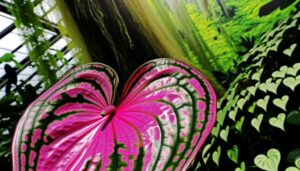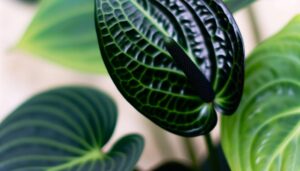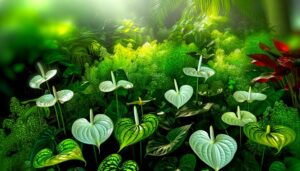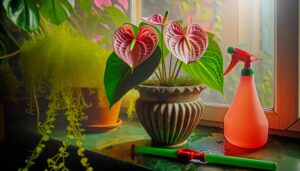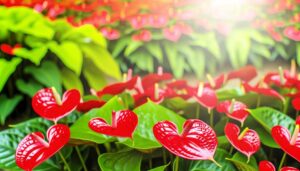3 Essential Tips for Caring for Anthurium Small Talk Red
To sustain Anthurium Small Talk Red health, peak, indirect light at 10,000 to 20,000 lux is essential, avoiding direct sunlight. Position near east or north-facing windows, or supplement with 5000K-6500K artificial grow lights.
Water consistently, keeping well-draining soil moist and using distilled or rainwater. Check the top inch of the substrate for dryness before watering and guarantee pots have drainage holes to prevent waterlogging.
Sustain humidity between 60% and 80%, using a hygrometer for monitoring. Utilize a humidifier, misting, or moisture trays as necessary.
Consistency in these conditions will help your Anthurium thrive, revealing further insights into prime care.
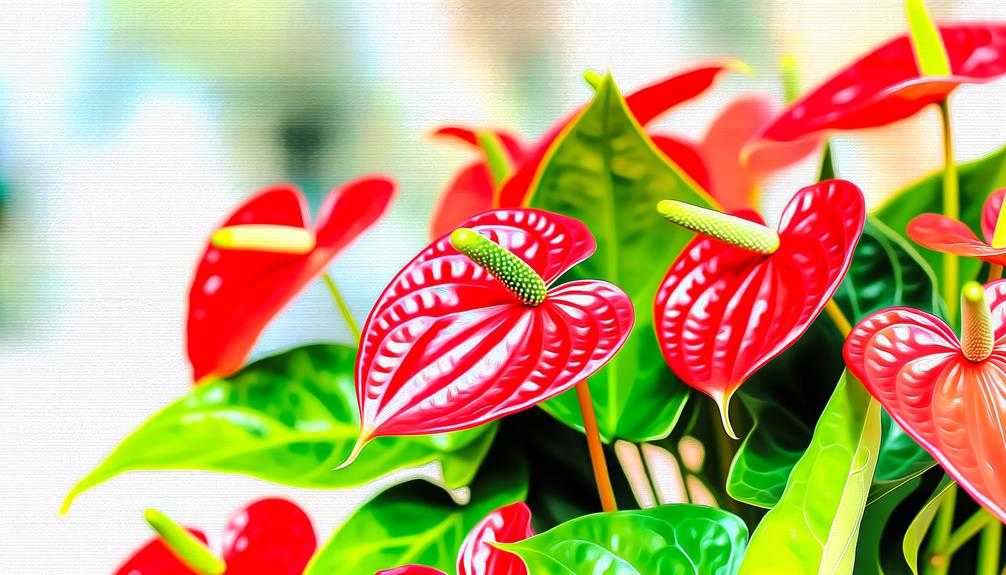
Key Takeaways
- Provide bright, indirect light of 10,000 to 20,000 lux for optimal growth.
- Water when the top inch of soil is dry, using distilled or rainwater.
- Maintain humidity levels between 60% and 80% to support healthy foliage.
- Keep temperatures consistently between 65-80°F to prevent plant stress.
- Fertilize every 6-8 weeks during the growing season with a diluted balanced liquid fertilizer.
Optimal Light Conditions
To achieve peak growth and vibrant blooms, Anthurium Small Talk Red requires bright, indirect light, ideally at an intensity of 10,000 to 20,000 lux. This can be measured using a light meter to guarantee precise lighting conditions.
Place the plant near east or north-facing windows, which typically provide the best illumination without direct sun exposure that can cause photodamage. Avoid positioning it under direct sunlight, as this can lead to chlorosis and necrosis of the foliage.
Artificial grow lights with a color temperature of 5000K-6500K can supplement natural light, especially in low-light environments. Consistency in light exposure is essential; fluctuations can stress the plant, impeding its physiological processes and diminishing its ornamental value.
Watering Practices
Maintaining appropriate watering practices is vital for the health and vigor of Anthurium Small Talk Red. This involves striking a balance between adequate hydration and preventing root rot. Anthurium plants thrive in consistently moist, well-draining soil. It is advisable to water them when the top inch of the substrate feels dry to the touch. This ensures that the water permeates thoroughly without causing stagnation.
Employing a pot with drainage holes is essential to avoid waterlogging. The use of distilled or rainwater, free from chlorine and fluoride, can help mitigate potential leaf tip burn. Monitoring the soil moisture level with a hygrometer can provide precise management. Avoid allowing the plant to sit in standing water, as this can lead to pathogenic fungal growth and root decay.
Ideal Humidity Levels
Ensuring ideal moisture levels, ideally between 60% and 80%, is crucial for the Anthurium Small Talk Red to prevent desiccation and promote vigorous foliage growth. Employing a hygrometer to monitor ambient moisture is recommended.
Should levels fall below the best range, consider deploying a humidifier to increase moisture content in the air. Additionally, situating the plant on a moisture tray filled with water and pebbles can effectively elevate localized moisture.
Misting the foliage with distilled water can also contribute to maintaining necessary moisture levels, though care must be taken to avoid excessive wetness, which may foster fungal growth. For indoor environments, maintaining proximity to other plants can create a microenvironment conducive to higher moisture levels.
Conclusion
To sum up, the Anthurium Small Talk Red thrives under specific conditions: ideal light, precise watering, and controlled humidity.
Making sure it gets bright, indirect light avoids leaf scorch, while consistent watering practices prevent root rot.
Keeping humidity levels between 60-80% mimics its native tropical setting.
By following these guidelines, one can guarantee the plant thrives, starting a new chapter in indoor gardening. Such careful attention ensures strong growth and colorful blooms, showcasing botanical excellence.

